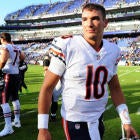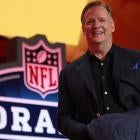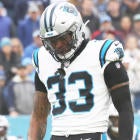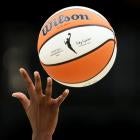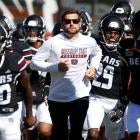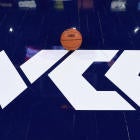Mitchell Trubisky didn't get the fanfare Deshaun Watson received after his first few NFL starts in 2017, but the Bears quarterback is coming off his best performance as a rookie, and has slowly acclimated to the professional game despite minimal experience at the collegiate level.
Think about this: Trubisky attempted 572 passes at North Carolina. Watson threw 1,207 passes at Clemson. We shouldn't have expected Chicago's signal-caller to be "ahead" of Houston's gunslinger early in their NFL careers.
Let's look back on Trubisky the prospect, compare and contrast his opening games for the Bears with recent outings, and pinpoint facets of his game in need of improvement.
Strengths
There's good reason the Bears were willing to move up to the No. 2 spot in the 2017 draft to pick Trubisky. He has essentially everything a club would want in a modern-day quarterback. At 6-feet-3 and 222 pounds, he has the requisite size. On film, his arm strength was apparent. As a passer, his accuracy at the short and intermediate levels was pinpoint. According to Pro Football Focus, his adjusted completion percentage on all throws in 2016 was 75.7. Watson's was 77.6. Pretty comparable.
Beyond that, Trubisky routinely demonstrated above-average athleticism for the position on roll outs, improvisational scrambles and designed runs.
Speaking of that, his accuracy didn't dip when throwing on the run, and he appeared to have the natural ability to calmly elude pass-rushers in the pocket while keeping his eyes downfield. Lastly, Trubisky rarely made bad decisions, as evidenced by his 30-to-6 touchdown-to-interception ratio in 2016 with the Tar Heels.
Weaknesses
Inexperience stood out more than anything else, although it wasn't something anyone could point to on film. He was the least-experienced Round 1 quarterback since at least 1978 based on starts at the collegiate level (13). That was the inherent risk with him ... teams knew he wasn't exposed to a variety of different situations, coverages, defenses, etc., in just one year as the North Carolina starter.
In terms of weaknesses his film did show, he was spotty at times as a downfield passer.
Per PFF, Trubisky had an adjusted completion percentage of 41.0 on throws made 20 or more yards downfield in 2016. For context, Watson's figure was 50.7. Patrick Mahomes' was 44.0.
Trubisky was my clear-cut No. 2 quarterback behind Watson, and someone I viewed as a late first-round prospect. I compared him to Ryan Tannehill. Both were ultimately top-10 picks despite their lack of vast experience in college.
First few starts
Crucially, during his first month or so as the Bears starter, Trubisky showed flashes of high-level quarterback skill, successful glimpses that became more frequent the more he played. Sometimes, the first few starts for a quarterback give "bust" warning signs. Although we shouldn't ultimately judge a signal-caller right away, in some instances, it's obvious a quarterback simply doesn't belong. That wasn't the case with Trubisky.
In his second start, a prime-time contest against a quality Ravens defense, Trubisky went just 8 of 16 and his touchdown was a somewhat fluky tipped ball. But he worked the middle of the field, and the spotlight didn't seem too big for him. After the bye week, he appeared significantly more comfortable for longer stretches of the game at home against the Packers.
Trubisky went 21 of 35 for 295 yards with one touchdown and no picks. While the rookie experienced a -- not uncommon -- lull after that, he did plenty to display the full array of his impressive skill set.
Last few starts
Trubisky has come into his own over the past two weeks. He has completed 37 of his past 47 passes (78.7 percent) at 7.93 yards per attempt with two touchdowns and no interceptions.
Chicago offensive coordinator Dowell Loggains has astutely given Trubisky more bootlegs -- which highlight his athleticism and give him easy reads -- and out-breaking primary targets from spread formations, the latter simulating the foundation of his wide-open aerial attack in college.
During October and into November, Tarik Cohen strangely wasn't involved much in the pass game after a blistering start to the season. Since then, Cohen has returned as an important aspect of what Chicago does through the air. He has registered 14 targets and made 12 catches for 67 yards in his past four games. Obviously, these are high-percentage, potentially high-reward pass plays for Trubisky.
Beyond that, rookie tight end Adam Shaheen, a matchup nightmare at 6-6 and 270-plus pounds, is fresh off the most targets (five), catches (four) and yards (49) of his young career in the Bears' convincing win in Cincinnati in Week 14.
Chicago's offensive coaching staff has emphasized the tight end and running back as good options for Trubisky to target.
Another sign of Trubisky's development -- sacks.
In his first five games, he averaged 3.25 sacks. In his last four, Trubisky has been sacked 1.75 times per game. That's an underrated indicator of how effective a quarterback is reading the field and getting the ball out of his hands. He has clearly been more decisive as he has gotten more experience.
Of course, Trubisky is far from being a finished product, and while he's clearly a gifted passer who can get away with some mechanical hiccups, bettering his footwork and eliminating some of the fade-away throws he has made -- despite their accuracy -- would allow his arrow to continue to point up as he nears the end of his rookie season.













